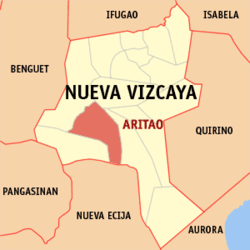Aritao
| Aritao | ||
|---|---|---|
| Municipality | ||
| Municipality of Aritao | ||
|
Maharlika Highway | ||
| ||
 Map of Nueva Vizcaya with Aritao highlighted | ||
.svg.png) Aritao Location within the Philippines | ||
| Coordinates: 16°18′N 121°02′E / 16.3°N 121.03°ECoordinates: 16°18′N 121°02′E / 16.3°N 121.03°E | ||
| Country |
| |
| Region | Cagayan Valley (Region II) | |
| Province | Nueva Vizcaya | |
| District | Lone district | |
| Barangays | 22 see Barangays) | |
| Government [1] | ||
| • Type | Sangguniang Bayan | |
| • Mayor | Lucing L. Tan | |
| • Electorate | 20,707 voters (2016) | |
| Area [2] | ||
| • Total | 265.60 km2 (102.55 sq mi) | |
| Population (2015 census)[3] | ||
| • Total | 37,225 | |
| • Density | 140/km2 (360/sq mi) | |
| Time zone | UTC+8 (PST) | |
| ZIP code | 3704 | |
| PSGC | 025002000 | |
| IDD : area code | +63 (0)78 | |
| Climate type | Tropical rainforest climate | |
| Income class | 2nd municipal income class | |
| Revenue (₱) | 138,114,145.29 (2016) | |
| Native languages |
Gaddang Ilocano Isinai Kallahan language Tagalog | |
| Website |
aritao | |
Aritao, officially the Municipality of Aritao, is a 2nd class municipality in the province of Nueva Vizcaya, Philippines. According to the 2015 census, it has a population of 37,225 people.[3]
The ethnic minority called Isinai (the same term for the local spoken dialect) were the original residents of this town. The name Aritao came from the Isinai phrase Ari Tau "which stands for "Our King" (ari=king & tau=our) which refers to the legendary Isinai Chieftain Mengal, a fierce and brave king who resisted Spanish conquest of the Isinai territories around Ajanas and Ynordenan (the areas comprising what is now most of Aritao).
Barangays
Aritao is politically subdivided into 22 barangays.
- Banganan
- Beti
- Bone North
- Bone South
- Calitlitan
- Comon
- Cutar
- Darapidap
- Kirang
- Nagcuartelan
- Poblacion
- Santa Clara
- Tabueng
- Tucanon
- Anayo
- Baan
- Balite
- Canabuan
- Canarem
- Latar-Nocnoc-San Francisco
- Ocao-Capiniaan
- Yaway
History
In 1942, Japanese troops entered Aritao, Nueva Vizcaya.
A monument to the gallantry of the Japanese and Filipino soldiers during World War II, located at Barangay Kirang, municipality of Aritao, Nueva Vizcaya. Built in 1978 by the Rakunsankai Society of Japan, it was recently rebuilt using a black glazed stone, and a memorial was engraved in the tablet in Japanese and English. Also offers a scenic view of reforested mountains and hills.
Demographics
| Population census of Aritao | ||
|---|---|---|
| Year | Pop. | ±% p.a. |
| 1903 | 477 | — |
| 1918 | 1,314 | +6.99% |
| 1939 | 6,208 | +7.67% |
| 1948 | 7,322 | +1.85% |
| 1960 | 11,209 | +3.61% |
| 1970 | 18,098 | +4.90% |
| 1975 | 19,075 | +1.06% |
| 1980 | 22,004 | +2.90% |
| 1990 | 25,942 | +1.66% |
| 1995 | 29,151 | +2.21% |
| 2000 | 31,705 | +1.82% |
| 2007 | 34,206 | +1.05% |
| 2010 | 37,115 | +3.01% |
| 2015 | 37,225 | +0.06% |
| Source: Philippine Statistics Authority[3] [4] [5] [6] | ||
Schools
- Aritao National High School
- Immaculate Conception Academy
- Saint Teresita's Academy
- Nueva Vizcaya Institute
- Santa Clara High School
Aritao also has a lot of schools for primary (elementary education).
Images
- Nueva Vizcaya Institute
- Twin (Skull and Salakot) mountains (visible from Aritao Townhall)
References
- ↑ "Municipality". Quezon City, Philippines: Department of the Interior and Local Government. Retrieved 31 May 2013.
- ↑ "Province: Nueva Vizcaya". PSGC Interactive. Quezon City, Philippines: Philippine Statistics Authority. Retrieved 12 November 2016.
- 1 2 3 Census of Population (2015). "Region II (Cagayan Valley)". Total Population by Province, City, Municipality and Barangay. PSA. Retrieved 20 June 2016.
- ↑ Census of Population and Housing (2010). "Region II (Cagayan Valley)". Total Population by Province, City, Municipality and Barangay. NSO. Retrieved 29 June 2016.
- ↑ Censuses of Population (1903–2007). "Region II (Cagayan Valley)". Table 1. Population Enumerated in Various Censuses by Province/Highly Urbanized City: 1903 to 2007. NSO.
- ↑ "Province of Nueva Vizcaya". Municipality Population Data. Local Water Utilities Administration Research Division. Retrieved 17 December 2016.
External links
| Wikimedia Commons has media related to Aritao, Nueva Vizcaya. |
